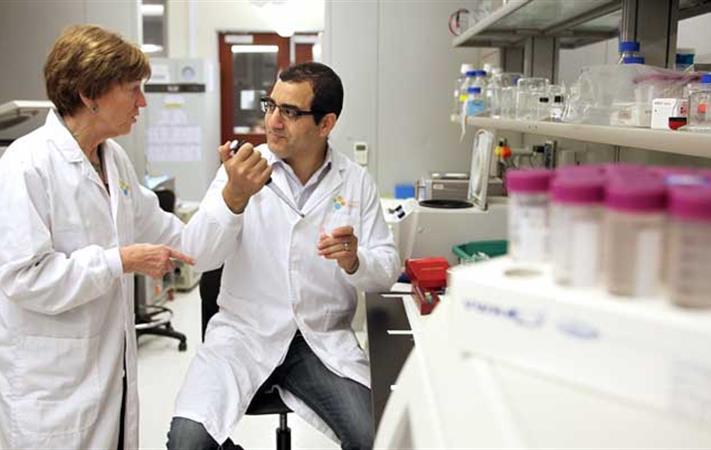Collaborative Work on Stress-Tolerant Crop Plants

Prof. Nina Fedoroff and Prof. Samir Hamdan
"This research could greatly contribute to modifying crop plants to confer stress tolerance, leading to an increase in crop yields and productivity." – Prof. Samir Hamdan
A significant collaboration between the labs of KAUST professors Samir Hamdan, Assistant Professor of Bioscience, and Nina Fedoroff, Distinguished Professor of Bioscience, has resulted in a paper published recently in the journal Nucleic Acids Research. The paper describes research that could help modify crop plants to better tolerate stressful conditions.
"In collaboration with Prof. Fedoroff's lab, my lab started a major initiative two years ago to significantly increase our contribution to the University's four main research thrusts of food, water, energy, and the environment," explains Prof. Hamdan. Prof. Hamdan and his team began investigating the biogenesis at the molecular level of a specific type of RNA (ribonucleic acid) called microRNA (miRNA) in plants.
In cells, genetic information is "transcribed" from DNA (deoxyribonucleic acid) to messenger RNA (mRNA), and is then "translated" into proteins, which carry out certain functions. miRNAs are short, non-coding RNA sequences that function by binding to specific sequences in "target" mRNAs, acting to regulate their translation and usually silencing them.
"miRNA is central throughout plant development and in a number of responses to stressful environments, including responses to drought, heat, high salt, and the effects of bacteria and viruses," says Prof. Hamdan. Understanding miRNA biogenesis is very important because "it could greatly contribute to modifying crop plants to confer stress tolerance, leading to an increase in crop yields and productivity."
Prof. Fedoroff's lab developed the first in vitro miRNA processing system, starting with outlining the genetic definition of miRNA processing pathways. "I feel very fortunate to work on miRNA's molecular characterization with Prof. Fedoroff," Prof. Hamdan states.
The researchers examined miRNA production in Arabidopsis thaliana, a model plant often used in molecular genetics studies. In Arabidopsis, the production of miRNA is controlled by an enzyme called DICER-LIKE 1 (DCL1) and two other proteins, HYPONASTIC LEAVES 1 (HYL1) and SERRATE (SE).
By examining the mechanism that produces primary miRNA (pri-miRNA), the precursor of miRNA, the researchers discovered that SE is integral to the processing of pri-miRNA by DCL1.
"SE is a conserved gene that plays a critical role in the biogenesis of miRNA in both plants and animals," says Prof. Hamdan. "In our study we have provided the first characterization of the interactions of SE with RNA and with DCL1 and the mechanism by which SE promotes the activity of DCL1."
By using highly purified proteins, the researchers found that DCL1 cleaves pri-miRNA, but SE "substantially enhances" the processing of the pri-miRNA, interacting directly with DCL1 and RNA. SE mainly interacts with RNA using its conserved N-terminal region, the end of the protein that terminates in a free amine (-NH2) group, with "minimal contribution" from other regions.
"Both SE's N-terminal region and its conserved zinc finger domain, a protein structural motif, are required for the interaction of SE with DCL1 in the absence of RNA," explains Prof. Hamdan. When DCL1 is bound to RNA, only SE lacking its N-terminal sequence can bind to DCL1 to stimulate processing, but if SE lacks its zinc finger domain, it cannot bind. "[T]he ability of the N-terminally truncated SE protein to stimulate DCL1 activity suggests that it does so directly and that RNA binding is not required for this stimulation," the researchers state.
"Our work shows that under physiologically relevant conditions, SE becomes integral for DCL1 activity in a substrate-specific manner," Prof. Hamdan says. "We propose that this could provide a potential point for regulation of miRNA processing."
He and his team were "surprised with the complexity of the interaction of SE with RNA and DCL1 because it involves RNA-promoted protein conformational changes and switches," he says. "This tells us that decoding the molecular mechanism of miRNA biogenesis is going to be difficult and exciting future research."
Collaboration with Prof. Fedoroff's lab is important because it brings together two "powerful complementary experimental approaches at KAUST," says Prof. Hamdan. Prof. Fedoroff's lab provides expertise in growing plant suspension cells and conducting plant genetics and cell biology studies, while Prof. Hamdan's lab "is expert in applying unique approaches that combine conventional biochemical and biophysical techniques with the real-time observation of single molecule imaging techniques to study the mechanisms of nucleic acid-binding multiprotein complexes," he explains.
In the future, Prof. Hamdan hopes that he and his team will be able to provide molecular images of miRNA biogenesis at the single molecule level with high spatial and temporal resolution. Then they may be able to fully "decode what appears to be a highly complex and dynamic mechanism," he states.

